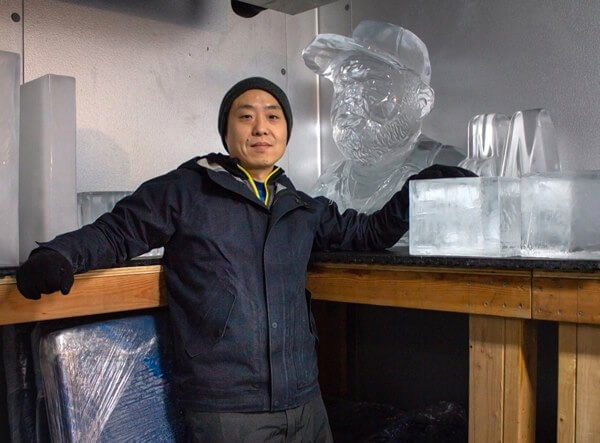By Tammy Scileppi
Icy shavings fly everywhere as the cameras flash. It’s not a hockey game, it’s the filming of an interesting new video series called “How to Make It” (now on YouTube), which comes to viewers from popular dining and food guide Eater.
The show gets hands-on with some of the craziest alternative jobs in the food world. During the first episode, host Katie Pickens from Food Network’s “Iron Chef” trades her normal utensils for a chainsaw as she gets schooled in extreme ice sculpting at Okamoto Studio Custom Ice, located at 35-03 31st St. in Long Island City.
Showing no fear, she gets cracking — literally — on an icy mystery project, and after powering through a large block, ends up with something unexpected. Her teacher is master ice sculptor Shintaro Okamoto, the studio’s founder and creative director.
“We recently collaborated with Eater and I showed the host how to carve a decorative ice bowl as a way of looking deep into the art of ice carving,” Long Island City’s iceman said. “It’s a great joy to have our studio in New York City, where many media outlets visit us to share [our work] with the widest of audiences.”
Okamoto, a longtime Astoria/LIC resident, said he’s excited about working with top tastemakers from every industry and noted that, while his studio’s main clientele tends be concentrated in Manhattan, his team has enjoyed working on numerous projects for borough-wide events and celebrations in Queens. Orders are often received from catering halls and private clubs. The studio also connects with clients from other states and even overseas — from Japan, Europe and beyond.
Using traditional hand tool craftsmanship — vee chisels and hand saws — and certain power tools, Okamoto and his team spend long hours sawing, carving, and etching as they create eye-catching, custom-made, handcrafted, crystal-clear works of art — from delicate ice wares to life-like sculptures to live performance carvings — for corporate, private, and nonprofit clients. Since 2003, the innovative studio has produced amazing installations, which have graced weddings and Bar Mitzvahs, cocktail bars and film premieres, as well as galas and fashion shows, including New York Fashion Week.
The studio collaborates on a variety of unique projects that have put smiles on people’s faces. You may have seen their towering ice heart sculpture in Union Square a while back.
“We carved a nine-foot-tall, life-size African elephant in Union Square for World Elephant Day, and have worked with Central Park Conservancy to create a series of sculpture replicas within the park for their annual Ice Festival,” said Okamoto.
A couple of winters ago, his ice men arrived at Barneys New York and transformed the store’s show windows into a fully operational ice carving studio during the holiday season, creating dazzling ice sculptures that wowed shoppers and passersby.
Onlookers were intrigued after Al Roker’s bespectacled ice bust — carved on site — was revealed during NBC’s “Today Show” last February, when Queens’ ice sculptor extraordinaire showed off his art with the public outside Rockefeller Plaza. Okamoto said sharing his art with people is his favorite thing to do.
It takes someone who possesses a strong creative streak to make ice magic happen, and Okamoto enjoys working with kindred spirits to transform chunks of plain ice into mind-blowing art. He said that, while his diverse team of contract artists from all backgrounds must have “a confident relationship with the tools,” the most important skills and qualities he looks for include “an ability to listen and a willingness to learn, combined with a considerate and collaborative attitude.”
“We enjoy our work, as it is challenging, rewarding, beautiful, and humbling,” he said.
Okamoto founded his business with his late father, Takeo in 2003, when they opened their first space near Long Island City’s Noguchi Museum. In 2009, they moved to their current 2500-square foot space — complete with walk-in freezers, production floor, and design office — which is a stone’s throw from the 36th Avenue subway station in Astoria.
“My father was a master ice sculptor, and I was drawing and painting until we decided to start the ice sculpture business,” Okamoto said. “New York City’s events industry is robust and innovative, ever-hungry for something new and creative, and we felt confident we can offer the most unique products.”
From the first sketch to the final cut and presentation, Okamoto Studio fulfills their clients’ needs and vision, translating their desires into the language of form, light, and evanescence.
“Once the design is finalized, it is posted to the production floor. Then the artist takes the design, studies its form, plans the amount of ice needed, and cuts the ice with a chainsaw to begin,” Okamoto said, describing the labor-intensive carving process. “No matter how big or small, about sixty percent of work is first done with an electric chain saw. We then refine the shape with chisels and finalize the details with die grinders of different bits.”
He said there is no average carving time on a particular project, as the design scale is different for each creation. But time does become a factor.
“Much of what we do is done outside the freezer where the ice is slowly, but surely, melting,” Okamoto said. “We have to be mindful of the time passing and we must commit to its completion without breaking, once started.”
Queens’ dynamic ice man pointed out that his favorite creations are the public installations, where he and his crew get to show the process of carving “to the most unassuming people, and make them smile, wonder, and appreciate what we do every day.”




































